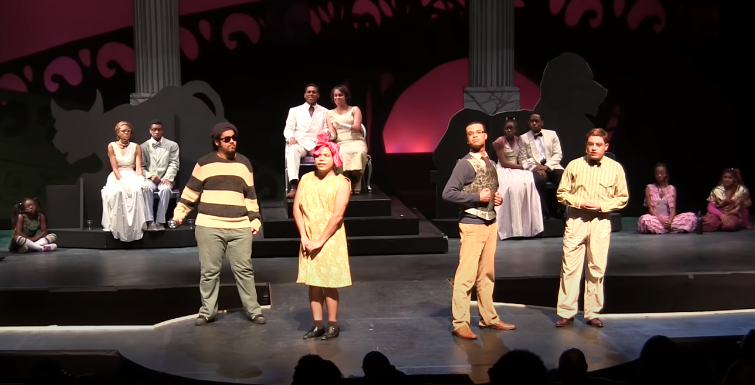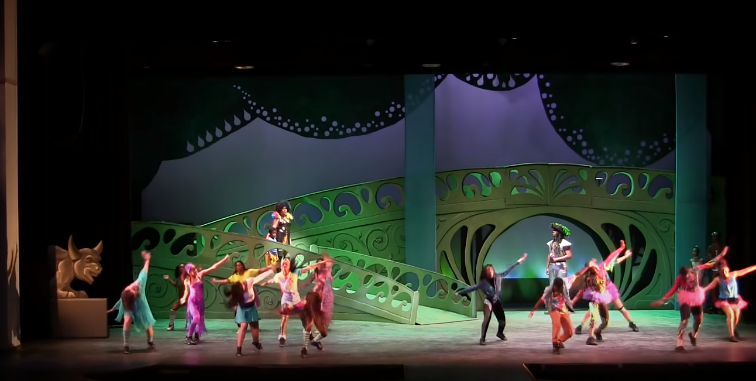For this assignment, I have chosen to examine the 2014 York College theatre’s rendition of a classic Shakespearian piece, Midsummer Night’s Dream. The performance took place in Milton G. Bassin Performing Arts Center, in Jamaica, Queens. This particular facility is affiliated with the York College and works with the aim of providing an opportunity to stage plays of varying scope to help the diverse local communities. For me, it sounds like a perfect place to stage a uniquely vibrant story the authors chose to depict. The reason I decided to examine this particular play is that I have always been fascinated by Shakespeare’s works and legacy. Having read many of his works in my leisure time, I felt like this choice would be the right one for me. Presented by director Matthew Katz, the comedy puts a modern spin on telling a classic tale. The play is 2.5 hours long and covers the 6 subplots that comprise the story. The plot is centered on the marriage between Theseus and Hippolyta, and many other characters are weaved into it. Different events are happening at the same time, resulting in comical and bizarre outcomes. This essay will focus on examining the characters, presentation, and the plot of the play, as well as providing my personal opinions on the aforementioned subjects.
When talking about theatre performance, one of the first aspects to discuss would be the actors and their characters. As the people that the audience pays the most attention to, actors are the ones that must shoulder the biggest responsibility for the success of the performance. From my experience, the characters in this play seemed to have exaggerated and bright personas, often speaking in a confident, booming voice, enhancing the dreamlike, performative atmosphere. The characters of Puck and Nick Bottom were especially notable to me, as they had a certain charm to them that made their presence that much more enjoyable. The former prances around the stage on roller-skates, with colorful wings attached to his back, emphasizing his role as a trickster fairy. The latter acting in obnoxious and humorous ways, often displays his large ego for everyone to see, seeking to outshine his fellow performers and take center stage.
The stylistic presentation of the play is also important to mention, as it forms the identity of the piece, and informs the viewer’s experience. In this regard, the stage directions for this performance were especially interesting given the nature of the source material. The dance numbers used a lot of acrobatic stunts and modern dance styles, and the musical score leans heavily into contemporary aesthetics. Notably, this version of Midsummer Night’s Dream uses a partially unique approach when it comes to character costumes. The human characters are dressed in formal and casual clothing of our time period, like suits and dresses, sparking an interesting contrast between an old narrative and a modern-looking presentation. Fairies are also dressed in similar clothing, however, their color pallets are much more vibrant and eye-catching, with many accessories and trinkets. This stylistic choice gives the story a fresh perspective and allows the people who have already seen this play to re-experience it. I think that the reason creators chose to present the characters in that way stemmed a desire to add a personal touch and modernize an already existing piece of culture.


Last, but not least, I would like to address the plot and my overall impressions of the play. As an adaptation of Shakespeare’s “Midsummer Night’s Dream”, the production shares its story beats with the famous comedy. The characters speak in poems, paying tribute to the source material and making the story more like a dream, not simply a retelling of events. The marriage of Theseus and Hippolyta serves as the narrative center of the whole piece, with all the other subplots happening around it. Theseus, as the Duke of Athens, is tasked with both arranging a festival and resolving a quarrel between Egeus and his daughter. The story also shows the audience a group of local actors that are trying to prepare a play for an upcoming event, failing miserably in the process. Fairies, are also present and play a major role in the events, with king Oberon and Queen Titania being especially prominent. Through a series of mistakes, misunderstandings, and random occurrences, all of the plots mesh together, creating a complex and entertaining narrative for the audience. I think that despite its unorthodox approach, the creators have managed to capture the attention of the viewer and creatively express themselves.
In conclusion, I would like to say that I thoroughly enjoyed watching this play. The characters were whimsical and well-portrayed, the set design was nice to look at and vibrant. Choreography and the presentation seemed a bit sloppy at times, but the energy and passion made up for them tenfold. Adaptation-wise, the story was adapted closely to the original and fairly easy to follow, with all the characters visually different from each other. The only major complaint I would have is the audio quality of the recording. The video had a lot of background static noise, and the sound was recorded in mono, making the viewing experience uncomfortable and sometimes painful for my ears. Overall, the play has left a positive impression on me, and I think I would recommend some of my theatre-loving friends to watch it.
References
Tom M. “A Midsummer Night’s Dream – full play.” YouTube, 2015. Web.